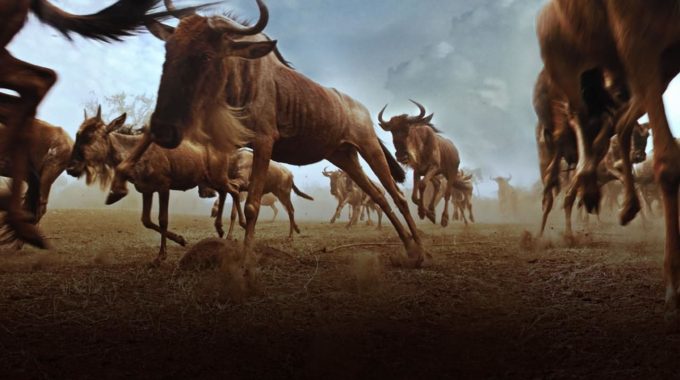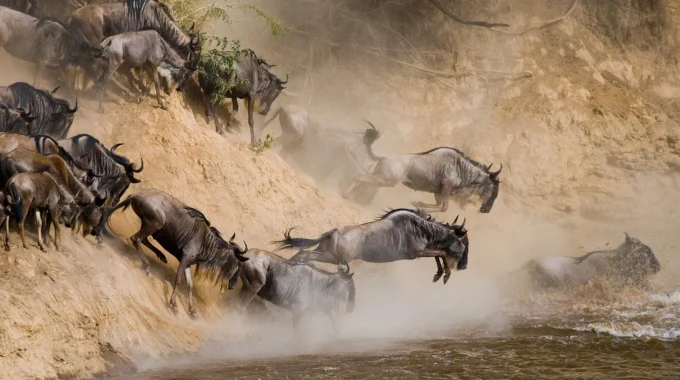A Kenya safari cost can vary significantly based on several factors, such as the season,…
How do you see the Great wildebeest migration?
How do you see the Great wildebeest migration? – To witness the Great Wildebeest Migration, you’ll need to visit key areas in Tanzania and Kenya where the migration takes place. The event spans across the Serengeti in Tanzania and the Masai Mara in Kenya, with different stages of the migration occurring at different times of the year. Here’s how to see it:

1. Choose the Right Location
The Great Wildebeest Migration takes place in two main countries: Tanzania and Kenya. Depending on when you visit, you’ll want to pick a location that aligns with the migration’s movements.
- Tanzania: Most of the migration occurs in the Serengeti National Park and the Ngorongoro Conservation Area (southern Serengeti). The wildebeest typically start the year here, calving in January to March before moving northwards.
- Kenya: The Masai Mara National Reserve in Kenya is the final destination for the migration as the herds cross the Mara River in the northern Serengeti region. The most dramatic river crossings happen between July and September when the wildebeests attempt to cross the Mara River.
2. Best Time to See the Migration
The migration is a year-round event, but the key moments vary by month:
- January to March: Calving Season in the southern Serengeti (Ndutu area and Ngorongoro Crater). During these months, over half a million wildebeest are born in a synchronized event, attracting predators. It’s a great time for those looking to see newborn animals and predator interactions.
- April to June: The wildebeest begin moving north toward the central Serengeti and then onward to the western Serengeti (Grumeti River) by early June.
- July to September: This is when the herds reach the northern Serengeti and Masai Mara in Kenya, and the iconic Mara River crossings happen. This is the most dramatic part of the migration, with thousands of wildebeests and other herbivores crossing dangerous rivers filled with crocodiles and lions waiting on the banks.
- October to December: After spending time in the Masai Mara, the herds start moving back south toward the Serengeti as the weather gets drier. By November and December, the herds are generally in the southern Serengeti again, preparing for another calving season.
3. How to Experience the Migration
- Game Drives: The most popular way to see the migration is on a safari with daily game drives. Most lodges and camps offer guided drives to key migration areas.
- Hot-Air Balloon Safari: For a unique view, you can take a hot-air balloon over the Serengeti or Masai Mara, giving you a bird’s-eye view of the herds moving across the landscape.
- River Crossings: The Mara River crossings in northern Serengeti and Masai Mara offer one of the most dramatic moments of the migration. To maximize your chances of witnessing this, you’ll want to be in northern Serengeti or Masai Mara between July and September.
- Mobile Camps & Luxury Lodges: Many safari companies offer mobile camps that move with the migration, positioning you close to the action. Luxury lodges in the right locations also offer unparalleled views and a front-row seat to the migration.
4. Best Viewing Locations
- Serengeti National Park (Tanzania): This is the epicenter of the migration, and you can experience it in various areas:
- Southern Serengeti (Ndutu and Ngorongoro) for calving season.
- Western Serengeti (Grumeti River) for early river crossings.
- Northern Serengeti (Kogatende) for the Mara River crossings.
- Masai Mara National Reserve (Kenya): From July to September, the wildebeest cross the Mara River, which is one of the highlights of the migration. Staying in a luxury tented camp or conservancy near the river gives you the best opportunity to see the dramatic crossings.
5. Safari Tour Packages
Many safari companies offer migration-focused tours that tailor the itinerary to the migration’s timing and location. Depending on your budget and preferred style of travel, you can choose:
- Luxury Lodges: High-end lodges that provide luxury and comfort, often with great locations along the migration path.
- Mobile Camps: These camps move with the migration, ensuring you’re positioned at the right spots during the best times for viewing.
- Budget Safaris: More affordable safari tours may have fixed itineraries but still allow you to experience the migration.
6. Tips for a Great Experience
- Book in Advance: The migration attracts a lot of tourists, especially during peak crossing times (July to September), so it’s advisable to book your safari well in advance.
- Be Patient and Flexible: Nature is unpredictable, and wildlife doesn’t always follow a schedule. If you’re hoping for river crossings or predator activity, it’s important to be flexible and patient.
- Use a Guide: An experienced guide can significantly enhance your safari experience by providing insights into animal behavior, migration patterns, and the best spots for viewing.
Conclusion:
To see the Great Wildebeest Migration, plan your safari around the specific locations and months where key events occur. The Mara River crossings (July to September) are the most dramatic moments, but the calving season and early migration stages are equally impressive for those interested in newborns and predator action. The migration is an extraordinary spectacle, and the right timing, location, and safari experience will ensure you have an unforgettable adventure.



